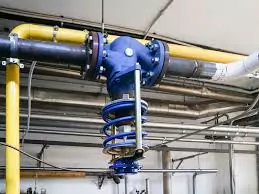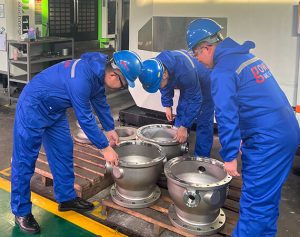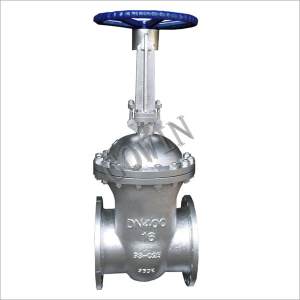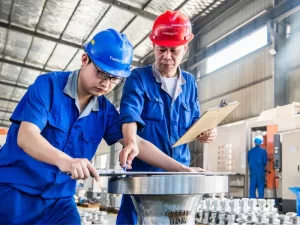Pneumatic control valves play crucial roles in various industries. One of which is the accurate control of fluids within systems. However, like any device, they are also prone to operational problems and issues. This suggests that you need to understand common control valve issues, as well as properly addressing them.
This article discusses typical pneumatic control valve problems. Moreover, it provides insights on control valve repairing techniques.
| Issue | Causes | Solutions |
| Valve Stiction | – Dirt on valve stem | – Clean and lubricate |
| – Improper lubrication | – Replace worn seals | |
| – Excessive packing tightness | – Adjust packing tightness | |
| Air Supply Problems | – Leaks in air supply | – Inspect for leaks |
| – Blockages in supply line | – Replace damaged tubing | |
| – Malfunctioning regulators | – Calibrate or replace regulators | |
| Actuator Malfunctions | – Worn diaphragms | – Replace faulty components |
| – Seized pistons | – Inspect actuators | |
| – Incorrect actuator sizing | – Ensure proper sizing | |
| Valve Hysteresis | – Poor valve calibration | – Recalibrate positioner |
| – Mechanical wear | – Replace worn parts | |
| Seat Leakage | – Damaged valve seats | – Inspect and replace seats |
| – Misalignment | – Ensure proper alignment | |
| Cavitation & Erosion | – High-velocity fluids | – Install anti-cavitation trims |
| – Pressure imbalances | – Use erosion-resistant materials | |
| Sluggish Response | – Inadequate air pressure | – Ensure proper airflow |
| – Blocked air lines | – Clean and lubricate | |
| Improper Sizing | – Mismatched flow rates | – Reassess system needs |
| – Incorrect valve size | – Replace with properly sized valves |
Valve Stiction
One of the most common pneumatic control valve issues is valve stiction. Here, the valve sticks and then moves suddenly. This causes inconsistency in process control. Erratic responses and decreased performance are additional outcomes of this issue.
Causes
- Dirt or debris on the valve stem or seating.
- Improper lubrication of the control valve linkage.
- Excessive packing tightness increases friction.
Solutions
- Regular cleaning and lubrication of the valve stem and linkage.
- Replace worn-out or damaged seals.
- Lubricate the control valve linkage.
- Adjust the packing to reduce excessive tightness.
Air Supply Problems
Pneumatic control valves depend on a consistent air supply to function. Disruptions in air supply are common scenarios. If unaddressed, it can severely affect the valve’s performance.
Causes
- Leaks in the air supply line or fittings.
- Blockages or clogging in the pneumatic supply line.
- Malfunctioning air pressure regulators.
Solutions
- Inspect the air supply system for leaks.
- Replace damaged tubing or connectors.
- Calibrate or replace the air pressure regulator.
Actuator Malfunctions
The actuator is a critical part of the pneumatic control valve. It is responsible for converting the control signal into valve movement. When the actuator malfunctions, it compromises the valve’s ability to perform efficiently.
Causes
- Worn diaphragms in diaphragm-type actuators.
- Corroded or seized pistons.
- Incorrect actuator size for the valve.
Solutions
- Replace faulty diaphragms or pistons that are worn or corroded.
- Regularly inspect actuators for corrosion.
- Ensure proper sizing for the valve’s operational requirements.
Valve Hysteresis
Hysteresis refers to the lag between the valve’s position and the control signal it receives. This often leads to inefficiency in process control.
Causes
- Poor calibration of the valve positioner.
- Mechanical wear in the valve linkage.
Solutions
- Recalibrate the valve positioner to ensure accurate feedback.
- Replace worn mechanical parts in the control valve linkage.
Control Valve Seat Leakage
Valve seat leakage is a critical issue that can lead to inefficiencies in process control. Some safety risks might also be involved. Knowing how to stop leaking at control valve and riser is essential in preventing system downtime and potential hazards.
Causes
- Damaged or worn-out valve seats.
- Misalignment between the valve plug and the seat.
Solutions
- Inspect and replace damaged valve seats.
- Ensure the valve plug and seat are aligned correctly.
Cavitation and Erosion
In certain high-pressure applications, cavitation and erosion can wear down the internals of the pneumatic control valve. The issue may lead to performance issues and potential valve failure.
Causes
- High-velocity fluids eroding the valve trim or body.
- Pressure imbalances may cause cavitation in liquid flow.
Solutions
- Install anti-cavitation trims for systems prone to cavitation.
- Use erosion-resistant materials.
Sluggish Valve Response
A slow or sluggish valve response is a frequent complaint in pneumatic systems. This issue can affect the process control accuracy and lead to inefficiencies.
Causes
- Inadequate air pressure.
- Blocked air lines.
- Sticky valve stems due to poor lubrication or dirt buildup.
Solutions
- Ensure proper air pressure and airflow.
- Clean and lubricate the valve stem.
Improper Valve Sizing
The size of the control valve plays a crucial role in its efficiency. An improperly sized valve can cause excessive wear, control inefficiencies, or even failure.
Causes
- Mismatched flow rates or pressure drops.
- Using a valve that is too large or too small.
Solutions
- Reassess system requirements.
- Replace valves that are inadequately sized.
Why Partner with a Reliable Valve Manufacturer?
While control valve repair and maintenance can address common issues, the long-term performance of your pneumatic control valve depends heavily on the quality of the valve itself. Therefore, choosing a reliable valve manufacturer is key to avoiding recurring problems.
Gowin is one of the leaders in worldwide valve manufacturing. The company has catered to giant industries across the globe. This testifies to the team’s trustworthiness and reliability.
Gowin has been in the game for 16 years. This company is a trusted valve manufacturer for the oil & gas, chemical, metallurgy, power stations, water supply, and energy industries.
They have a comprehensive range of valves for your business needs, These include ball valves, gate valves, globe valves, check valves, butterfly valves, copper valves, and needle valves.








